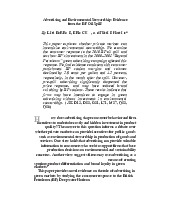

Preview text:
lOMoAR cPSD| 40799667 Summary
Advanced reading (Đại học Khoa học Xã hội và Nhân văn, Đại học Quốc gia Thành phố Hồ Chí Minh) lOMoAR cPSD| 40799667 A range of recent analyses has begun to shed light on
the potential of small cities and rural communities to make use
of knowledge, relationships and creative resources to position themselves more effectively in global networks and stimulate growth
(Brouder, 2012; Bell & J ayne, 2006;
Pierce, Martin & Murphy, 2011; OECD, 2014). But one the city
made the bold decision to develo p a programme of events commemorating the 500 th anniversary of Boscha standard or example for imitation or compariso nmiracle the more creatives, the more creative and there fore , attractive the city. How can places that lack large
populations or significant clusters of resources compete
effectively against and other larger places that dominate the
global economy? Some have argued that one developmental opportunity
for small places is the development of creative resources and
Our research concluded that The important
elements of the models of Sacco and Blessi and
Bucci et al. include: developing cultural quality, development of
local enterprises and talent, attracting firms and talent, reducing marginality, capacity building, participation, education and networking. The
city achieved this by setting up a network of
overtourism people have a reason to be creative in a particular place.
Are cities with a long history now
suffering a quick death at the hands of tourism? Building on the work of Sacco and Blessi, Bucci, Sacco & Segre (2014) propose an endogenous growth model based on
investment in culture and human resources. In the past ,
smaller places have had to resort to in physical terms
(Alonso, 1973; Meijers & Burger, 2015), but the advent of the network society means there are new potential strategies
for smaller cities to compete effectively. In many locations, therefore,
rural environments have provided t o be
successful in developing creative tourism programmes. Similarly,
using Sencreativity trapcreative class economic growth follows people, and in particular creative people. The difference between and may seem small, but in terms of orientation, process and outcome, they are poles apart.
These challenges are already evident in the early stages of the CREATOUR
project. Creative tourism experiences are not only economically valuable,
but may stimulate the development of new ideas, products, and services through the interactions,
conversa tions, and co - creation experiences that occur.
This argument has tended to focus attention on
large cities that have concentrations of creative industries and clusters of creative people. Smart endogenous growth: cultural capital and the creative use of skills. The lOMoAR cPSD| 40799667 debate about the
role of smaller places is also now
extending to the tourism field. This strategy was so successful
that the city eventually managed to gather 17 of the 25 surviving
paintings and almost all of the drawings. Rather than trying to emulate bigger places, small cities and rural
areas need to develop their own creative modes and practices
that are more sui ted to their scale and pace of life. Thi s underlines the importance of creatively seeking what is characteristic or special about each location in order to
provide engaging and unique experiences. Tourism &
Management Studies , 15(SI), 7 - 1 0 10 By adopting
creative practices, and thinking holistically about
creativity as a mode of being rather than as a sector or a social
group, small places have a better chance of creating interesti ng
alternatives to the development models of big cities.
This paper tries to assess the creative potential of s maller
places and how creative tourism might play a role in their
creative development strategies. Creative tourism consumers desire to and to
directly participate in creation and co - creation activities .
The city is the birthplace of the
famous medieval painter Hieronymus Bosch, who lived,
worked and died t here. The
whole Bosch programme attracted
1.4 million visits in total. This is perhaps a se nsible
strategy for major cities with significant cultural, creative and
financial resources, but what about smaller places?
For example, an event
can provide a useful
framing device for creativity, and also act as a temporal
concentrator and temporary re - sizing strategy. Recent years
have seen more attention being paid to the creative potential
of smaller places. In G. Richards & P. Russo, (eds),
Alternative and Creative Tourism (pp. 70 -
81), Arnhem: ATLAS. This means th at many of the projects have
similar ideas, such as using gastronomy, ceramics or textiles
as a basis for creative tourism. Very often , smaller p laces
do not possess the knowledge required to develop all aspects
of creative programmes successfully. Creative Tourism in
Balicreate sizecreative citiescreative districts Smaller
Cities. Lewis, N. M., & Donald, B. (2009). The challenge of
creative touri sm. Ethnologies , 38(1 - 2), 31 - 45. Richards,
G. (2017). European Culture Capitals and Local Development Strategies:




